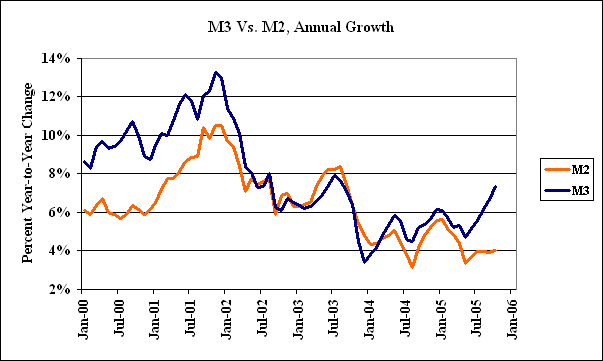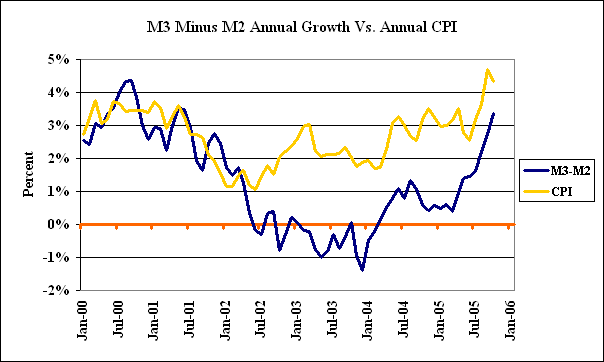November 2005 Edition - Supplement (Re: M3)
JOHN WILLIAMS' SHADOW GOVERNMENT STATISTICS
Issue Number 13B
(Supplement to Regular November Edition)
November 23, 2005
_____
Fed Abandons M3 Without An Honest Explanation
Action Will Obfuscate Rapid Money Growth
Ideal Environment for An Inflationist Fed Chairman and Conspiracies
Unilaterally and without reasonable explanation, the Fed has decided to stop reporting money supply M3, the broadest of the monetary aggregates and probably the most important statistic published by the U.S. central bank. The decision comes as a shock to many in the financial community and apparently to other central banks, which reportedly were not consulted.
One obvious explanation that makes sense is that the Fed does not want anyone to see what Presumptive Fed Chairman Ben Bernanke is going to do to broad money growth. Suggestions that Mr. Bernanke has the odor of an inflationist about him are not going to help quell the speculation. Something is terribly afoul at the Fed, but the popular financial press offers little but moronic platitudes and attacks on "conspiracy theorists" who dare to question the sanctity of the Federal Reserve Board.
I even saw one related comment yesterday from a well known financial reporter who laughed at the concept of there being a Plunge Protection Team that intervenes in troubled stock markets. She cited such a concept as evidence of the absurdity of some conspiracy theories.
I first saw the term "Plunge Protection Team" used in 1997 by the Washington Post, when it published an extensive article detailing the activities of the Working Group on Financial Markets. Anyone interested in this "imaginary" group, which includes the Fed Chairman, might wish to read the article, "Plunge Protection Team." It was authored by Post staff writer, Brett D. Fromson, and it appeared on Sunday, February 23, 1997.
And for what it's worth, my colleague, Doug Gillespie, published a piece on his website on November 14th entitled, "Bye-Bye, M3, but Why?" There was an outpouring of reader response to Doug's article, and to a person, respondents expressed the opinion that the Fed's action failed -- and failed badly -- the smell test.
Sorry for the diversion, but there is a point to this. The Federal Reserve, not the Treasury, generally is the ultimate backstop for the financial markets. Sometimes the Fed does intervene on behalf of the Treasury, particularly in the currency markets. Despite Mr. Greenspan's denials of Federal Reserve Involvement in stock market intervention, I have had a former Fed official confirm to me that interventions, at times, have been coordinated by the New York Fed.
Mr. Greenspan often does not make accurate statements, despite his carefully chosen words. He knows very well where the economy and financial markets are headed; he sometimes even talks about it. With the federal deficit out of control and the U.S. dollar vulnerable to a massive sell-off, there is a looming problem in getting someone to buy all the securities that are going to be issued by the U.S. or dumped by existing investors.
The ultimate solution likely will be Fed monetization of debt, which would tend to increase the money supply as reported in M3. In turn, the heavy monetization would evolve into a pattern of accelerating inflation (See SGS article of July 2005, "Federal Deficit Reality: An Update"). Oh, how nice it would be for Mr. Bernanke not to have to report those nasty M3 statistics.
(As an aside, the price of physical gold is up more than $20 or about 4.5% since the Fed's M3 announcement; the Philadelphia Gold & Silver Index [XAU] has risen more than 10%. Perhaps this is merely a coincidence... but maybe, it is not!)
The Fed's Version and My Counterpoint
On Thursday afternoon, November 10th, after the credit markets had closed for the long Veteran's Day weekend, the Board of Governors of the Federal Reserve System announced it would "cease publication of the M3 monetary aggregate," effective March 23, 2006. As the broadest measure of domestic liquidity, M3 is a key leading indicator and driving factor of both economic activity and inflation (see the May and June 2005 SGS "Reporting Foci" on the money supply).
Why has the Fed suddenly abandoned M3 and its non-M2 components of jumbo CDs, repos and Eurodollars? No explanation was given with the announcement, but a pre-packaged, explanatory e-mail, received by inquirers from a Federal Reserve public affairs officer, advised that:
"M3 does not appear to convey any additional information about economic activity that is not already embodied in the M2 aggregate. The role of M3 in the policy process has diminished greatly over time. Consequently, the costs of collecting the data and publishing M3 now appear to outweigh the benefits."
The proffered rationale is utter nonsense. In October 2005, seasonally-adjusted M2 was $6.6 trillion, while M3 was $10.1 trillion. It is incredible that the Fed would even suggest that the shifts in and growth of the $3.5 trillion in non-M2 assets had no meaning.
The senselessness of the Fed's statement can be demonstrated by a quick glance at the following two graphs. The first graph shows year-to-year change in both the M3 and M2 measures, the second graph shows the difference of M3 growth less M2 growth, against annual change in CPI-U inflation.


As to M3 conveying no information not already embodied in M2, consider the first graph of M2 and M3 growth during the last five years. While the series move together 80% of the time, there have been some interesting divergences, particularly the one at hand. For most of this year, annual M2 growth has held around 4%, but M3 has been accelerating towards 8%. If one thought M3 had any meaning, pending inflation might be a question. That clearly is not the case with M2, however, which fortunately contains all the meaningful information both the Fed and the public will ever need, or so suggests Mr. Greenspan.
Since M2 embodies all the information in M3, subtracting M2 growth from M3 growth should be a useless exercise. Yet, the plot of that difference has about a 60% correlation with annual CPI growth. It even might suggest there has been a little bit of monetary-inflation pressure mixing in with oil prices, recently.
Finally, despite the strong M3 growth in nominal terms, net of inflation (calculated on a pre-Clinton Era basis), a reliable recession signal was generated several months back. Of the liquidity measures, inflation-adjusted M3 is the best leading indicator of economic activity (see SGS "Reporting Focus" of May 2005).
What game the Federal Reserve is playing will become clear soon enough. Chances that M3 was eliminated because it just duplicated M2 are nil. The cost factor also is a canard. The Fed could privatize monetary reporting, if it wanted to, the same way the government put the Index of Leading Economic Indicators out to bid.
NOTE: If you should have any questions or comments about this article, please feel encouraged to express them via the SGS website's "Contact Us" link. If you would like a response, be sure to include your name and e-mail address.